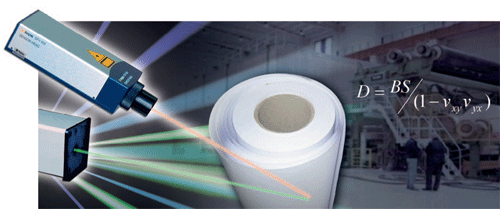Laser Ultrasonic Measurement Of Bending Stiffness On Moving Paper: A Mill Demonstration
•Full Article: Laser Ultrasonic Measurement Of Bending Stiffness On Moving Paper: A Mill Demonstration
A laser-based ultrasonic system for non-contact, in-process measurement of the elastic properties of paper was successfully tested at an operating paper mill with web speeds exceeding 20 m/s. The paper's flexural rigidity and out-of-plane shear rigidity were calculated from the frequency dependence of the phase velocity of ultrasonic waves generated in the moving paper by a pulsed Nd:YAG laser and detected with a Polytec Laser Vibrometer.

When a 15 to 30-ton paper roll is manufactured, a few samples are obtained from the end of the roll and analyzed for their mechanical properties to determine the paper's quality. In the case of copy paper, bending stiffness and flexural rigidity are very important. If the samples don't meet certain specifications, the entire roll is recycled into pulp or sold as an inferior grade. To avoid making a costly mistake, manufacturers often over-engineer the paper and use more pulp than necessary to ensure the final productisn't substandard.
To minimize the consumption of excess raw material and energy, a team of scientists from the U.S. Department of Energy's Lawrence Berkeley National Laboratory and the Institute of Paper Science and Technology at the Georgia Institute of Technology developed a sensor that tracks paper flexibility on the fly, in real time. Specifically, the sensor measures the time it takes ultrasonic Lamb waves to propagate from a laserinduced excitation point on the moving paper to a detection point several millimeters away. The velocity of the ultrasonic waves is related to two elastic properties of the paper: bending stiffness and out-of-plane shear rigidity.
The Laser Ultrasonic Sensor (LUS) has been successfully used to measure mechanical properties of paper in the laboratory. With the recent, successful testing at an operating paper mill, the paper industry is one step closer to saving millions of dollars each year. When feedback control is fully implemented, the sensor can ensure that the optimum amount of raw material is used to make the paper, reducing the consumption of trees and chemicals and saving the U.S. industry as much as $200 million in energy costs and up to $300 million in fiber costs each year.
Click Here To Download:•Full Article: Laser Ultrasonic Measurement Of Bending Stiffness On Moving Paper: A Mill Demonstration
